|
 This article entitled "The Boom in
R/C Boats" appeared in the June 1955 edition of Popular Electronics
magazine which, during the early years of its existence devoted quite a bit of print
space to radio control airplanes, boats and cars. As with all things electronics,
a huge surge in consumer interest was occurring with over-the-air communications.
Bill (William) Winter served as the editor of the Academy of Model Aeronautics'
(AMA's) American Modeler and American Aircraft Modeler magazines
from 1966 through 1974, but his efforts to promote all form of modeling - airplanes,
helicopters, cars, boats, trains, and rockets - covered many decades. His first
recorded article, "Building the Famous Udet Flamingo," (co-authored by Walter McBride),
was published in the March 1935 issue of Universal Model Airplane News
magazine... This article entitled "The Boom in
R/C Boats" appeared in the June 1955 edition of Popular Electronics
magazine which, during the early years of its existence devoted quite a bit of print
space to radio control airplanes, boats and cars. As with all things electronics,
a huge surge in consumer interest was occurring with over-the-air communications.
Bill (William) Winter served as the editor of the Academy of Model Aeronautics'
(AMA's) American Modeler and American Aircraft Modeler magazines
from 1966 through 1974, but his efforts to promote all form of modeling - airplanes,
helicopters, cars, boats, trains, and rockets - covered many decades. His first
recorded article, "Building the Famous Udet Flamingo," (co-authored by Walter McBride),
was published in the March 1935 issue of Universal Model Airplane News
magazine...
 It would be interesting to do a side-by-side
comparison on what was considered engineered
control line
stunt model airplane design in 1957, when this article was written, to what
is today considered to be optimal design criteria. I am trying to get back into
control line stunt flying and have one model built currently, the Enterprise-E.
It has been flown a few times and is (was) extremely sensitive on the controls when
set up per the plans. A little bit of control handle movements resulted in a huge
amount of both elevator and flap deflection. Fortunately, access to the flap control
horn is available through the removable top fuselage hatch, so I was able to relocate
the pushrod from the bellcrank to the flap horn, and then from the flap horn... It would be interesting to do a side-by-side
comparison on what was considered engineered
control line
stunt model airplane design in 1957, when this article was written, to what
is today considered to be optimal design criteria. I am trying to get back into
control line stunt flying and have one model built currently, the Enterprise-E.
It has been flown a few times and is (was) extremely sensitive on the controls when
set up per the plans. A little bit of control handle movements resulted in a huge
amount of both elevator and flap deflection. Fortunately, access to the flap control
horn is available through the removable top fuselage hatch, so I was able to relocate
the pushrod from the bellcrank to the flap horn, and then from the flap horn...
 When Melanie and I got married in 1983,
part of her dowry included some of the toys she had as a little girl. A
Hasbro Lite-Brite
was one of them. Our kids played with it when they were young, but somewhere along
the line during our many household moves, it disappeared. We probably donated it
to the Salvation Army at some point - a lot of our stuff has ended up there. About
a month ago we started watching for a good one on eBay that didn't cost too much.
Finally, there was a 1967-vintage Lite-Brite in like-new condition up for auction
that we got for around $45. It has a nice box... When Melanie and I got married in 1983,
part of her dowry included some of the toys she had as a little girl. A
Hasbro Lite-Brite
was one of them. Our kids played with it when they were young, but somewhere along
the line during our many household moves, it disappeared. We probably donated it
to the Salvation Army at some point - a lot of our stuff has ended up there. About
a month ago we started watching for a good one on eBay that didn't cost too much.
Finally, there was a 1967-vintage Lite-Brite in like-new condition up for auction
that we got for around $45. It has a nice box...
 Per "Wild Bill" Netzenband's report in this
1961 issue of American Modeler magazine covered the Vancouver Bi-Liners,
MAC highlights, Alan Nichols' success in Thompson Trophy Racer events, encouraging
clubs to adopt the affordable, and slow-flying contests. He addresses backlogged
club crest submissions, noting the impracticality of featuring all due to volume.
Alan Nichols debunks the myth that models wear out quickly, citing his year-old
Nobler and a five-year-old Fierce Arrow with original engine. Memories resurface
of McDonnell Aircraft's picnic air shows, where Phil Hamm's reliable metal jet stood
out. Southern California's new Control-Line Association, led by John Gudvangan and
others, seeks enthusiasts. Detroit's Metropolitan Speed Association unveils an $8,000
Rouge Park speed circle, aiming for a competitive... Per "Wild Bill" Netzenband's report in this
1961 issue of American Modeler magazine covered the Vancouver Bi-Liners,
MAC highlights, Alan Nichols' success in Thompson Trophy Racer events, encouraging
clubs to adopt the affordable, and slow-flying contests. He addresses backlogged
club crest submissions, noting the impracticality of featuring all due to volume.
Alan Nichols debunks the myth that models wear out quickly, citing his year-old
Nobler and a five-year-old Fierce Arrow with original engine. Memories resurface
of McDonnell Aircraft's picnic air shows, where Phil Hamm's reliable metal jet stood
out. Southern California's new Control-Line Association, led by John Gudvangan and
others, seeks enthusiasts. Detroit's Metropolitan Speed Association unveils an $8,000
Rouge Park speed circle, aiming for a competitive...
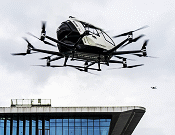 This article entitled "Why Pilots Will Matter
in the Age of
Autonomous Planes" appeared in the June 2025 issue of IEEE's Spectrum
magazine. "Long after planes start flying themselves, humans will still be in the
loop. In August 2001, an anonymous guest posted on the forum at Airliners.net, a
popular aviation website. 'How Long Will Pilots Be Needed?' they wondered, observing
that '20 years or so down the road' technology could be so advanced that planes
would fly themselves. 'So would it really be useful for a person to go to college
now and be an airline pilot if a few years down the road they will be phased out
by technology?' Twenty-four years later, the basic technology required to make aircraft
fly themselves exists, as evidenced by the fact that most commercial flights are
flown largely on autopilot..." This article entitled "Why Pilots Will Matter
in the Age of
Autonomous Planes" appeared in the June 2025 issue of IEEE's Spectrum
magazine. "Long after planes start flying themselves, humans will still be in the
loop. In August 2001, an anonymous guest posted on the forum at Airliners.net, a
popular aviation website. 'How Long Will Pilots Be Needed?' they wondered, observing
that '20 years or so down the road' technology could be so advanced that planes
would fly themselves. 'So would it really be useful for a person to go to college
now and be an airline pilot if a few years down the road they will be phased out
by technology?' Twenty-four years later, the basic technology required to make aircraft
fly themselves exists, as evidenced by the fact that most commercial flights are
flown largely on autopilot..."
 This is the February 8, 1942, "Flyin' Jenny" comic strip. The Baltimore Sun newspaper, published
not far from where I grew up near Annapolis, Maryland, carried "Flyin' Jenny" from
the late 1930s until the strip ended in the mid 1940s, so I saved a couple dozen
from there. The first one I downloaded has a publication date of December 7, 1941
- that date "which will live in infamy," per President Roosevelt. Many Americans
were receiving word over the radio of the Japanese attack on Pearl Harbor while
reading this comic at the breakfast table. I expect that soon there will be World
War II themes. "Flyin' Jenny," whose real name was Virginia Dare (what's in
a name?), was a test pilot for Starcraft Aviation Factory who divided her time between
wringing out new airplane designs and chasing bad guys. She was the creation of
artist and storyteller Russell Keaton... This is the February 8, 1942, "Flyin' Jenny" comic strip. The Baltimore Sun newspaper, published
not far from where I grew up near Annapolis, Maryland, carried "Flyin' Jenny" from
the late 1930s until the strip ended in the mid 1940s, so I saved a couple dozen
from there. The first one I downloaded has a publication date of December 7, 1941
- that date "which will live in infamy," per President Roosevelt. Many Americans
were receiving word over the radio of the Japanese attack on Pearl Harbor while
reading this comic at the breakfast table. I expect that soon there will be World
War II themes. "Flyin' Jenny," whose real name was Virginia Dare (what's in
a name?), was a test pilot for Starcraft Aviation Factory who divided her time between
wringing out new airplane designs and chasing bad guys. She was the creation of
artist and storyteller Russell Keaton...
 This is the complete set of
Peanuts Skediddlers,
sold by Mattel. Linus is extremely difficult to find, and when you do, he typically
sells for $200 or more. If you find a Linus Skediddler with the original box, expect
to pay $400. Over time, our (Melanie and me) Peanuts collection of memorabilia has
grow from the few items she had left over from her girlhood to complete sets. Everything
was gotten via eBay auctions. It took a lot of patience to be able to get good quality
items at an affordable price. Here is a bit of history I gathered on the Skediddlers.
Phenomenon: In the mid-to-late 1960s, Mattel capitalized on the explosive popularity
of Charles M. Schulz's Peanuts comic strip by releasing the Skediddler - a line
of friction-powered toys. Unlike wind-up mechanisms, these toys relied on a simple
push-and-go design: sliding them across a surface activated internal gears, causing
the characters' limbs and heads to jerk in a whimsical "skedaddling"... This is the complete set of
Peanuts Skediddlers,
sold by Mattel. Linus is extremely difficult to find, and when you do, he typically
sells for $200 or more. If you find a Linus Skediddler with the original box, expect
to pay $400. Over time, our (Melanie and me) Peanuts collection of memorabilia has
grow from the few items she had left over from her girlhood to complete sets. Everything
was gotten via eBay auctions. It took a lot of patience to be able to get good quality
items at an affordable price. Here is a bit of history I gathered on the Skediddlers.
Phenomenon: In the mid-to-late 1960s, Mattel capitalized on the explosive popularity
of Charles M. Schulz's Peanuts comic strip by releasing the Skediddler - a line
of friction-powered toys. Unlike wind-up mechanisms, these toys relied on a simple
push-and-go design: sliding them across a surface activated internal gears, causing
the characters' limbs and heads to jerk in a whimsical "skedaddling"...
 This 1949 Air Trails magazine article
warns that the
Soviet
Union has surpassed the U.S. in military aircraft production by a 15-to-1 margin,
with advanced jet fighters, bombers, and long-range piston-engine planes already
operational. Soviet scientists have also conducted atomic tests and are close to
producing compact A-bombs. Intelligence reveals a Red Air Force of 15,000 first-line
aircraft, including 2,400 jets, some surpassing American designs. The Soviets broke
the sound barrier before the U.S. and have developed powerful turbojet engines,
some with innovative features like variable-pitch stators. German scientists and
captured technology accelerated Soviet progress, particularly in rocketry and jet
propulsion. Their aircraft feature advanced construction techniques, such as metal-plywood
sandwich wings, and superior armament... This 1949 Air Trails magazine article
warns that the
Soviet
Union has surpassed the U.S. in military aircraft production by a 15-to-1 margin,
with advanced jet fighters, bombers, and long-range piston-engine planes already
operational. Soviet scientists have also conducted atomic tests and are close to
producing compact A-bombs. Intelligence reveals a Red Air Force of 15,000 first-line
aircraft, including 2,400 jets, some surpassing American designs. The Soviets broke
the sound barrier before the U.S. and have developed powerful turbojet engines,
some with innovative features like variable-pitch stators. German scientists and
captured technology accelerated Soviet progress, particularly in rocketry and jet
propulsion. Their aircraft feature advanced construction techniques, such as metal-plywood
sandwich wings, and superior armament...
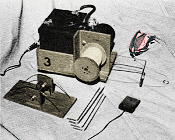 A long time ago (circa
1977) I bought a used glider winch at an auction held by the Prince Georges Radio
Club, in Maryland. It cost me somewhere around $25, which was a lot for me in the
mid 1970s. The motor and control circuitry was contained in a plywood box, with
a jack for the foot switch and terminals to clamp jumper cable to from a car. In
looking at these plans for the
AAM Glider Winch shown
here from the April 1973 American Aircraft Modeler, it looks a lot like mine, only
mine was in a wooden box. It worked extremely well for my 99"
Windfree and 99"
Aquila sailplanes. Unfortunately,
I sold it shortly after getting married in 1983 (couldn't eat the winch). I would
love to have it back. Actually, what I would rather have at this point is a winch
that is powered by a cordless drill that would be lighter... A long time ago (circa
1977) I bought a used glider winch at an auction held by the Prince Georges Radio
Club, in Maryland. It cost me somewhere around $25, which was a lot for me in the
mid 1970s. The motor and control circuitry was contained in a plywood box, with
a jack for the foot switch and terminals to clamp jumper cable to from a car. In
looking at these plans for the
AAM Glider Winch shown
here from the April 1973 American Aircraft Modeler, it looks a lot like mine, only
mine was in a wooden box. It worked extremely well for my 99"
Windfree and 99"
Aquila sailplanes. Unfortunately,
I sold it shortly after getting married in 1983 (couldn't eat the winch). I would
love to have it back. Actually, what I would rather have at this point is a winch
that is powered by a cordless drill that would be lighter...
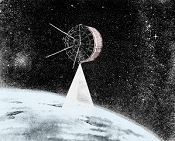 We take for granted most of the technology
that surrounds us. Unless you were alive 60 years ago at the dawn of microelectronics
and space flight, it would be difficult to imagine a world without cellphones, desktop
computers, color TVs, the Internet, and even
satellite-base weather forecasting. Everyone likes to make jokes about weathermen
being no better at predicting the weather than your grandmother's roomatiz[sic],
but the fact is that, especially for short-term (2-3 days) predictions, we get pretty
good information. As a model airplane flyer, I check the wind level forecast nearly
every day to see whether my model plane can handle it. AccuWeather's free hourly
forecast is usually pretty darn accurate for today's and tomorrow's wind... We take for granted most of the technology
that surrounds us. Unless you were alive 60 years ago at the dawn of microelectronics
and space flight, it would be difficult to imagine a world without cellphones, desktop
computers, color TVs, the Internet, and even
satellite-base weather forecasting. Everyone likes to make jokes about weathermen
being no better at predicting the weather than your grandmother's roomatiz[sic],
but the fact is that, especially for short-term (2-3 days) predictions, we get pretty
good information. As a model airplane flyer, I check the wind level forecast nearly
every day to see whether my model plane can handle it. AccuWeather's free hourly
forecast is usually pretty darn accurate for today's and tomorrow's wind...
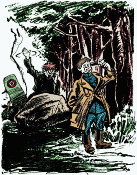 In this 1937 "Smoke Scream" in a 1937 issue
of Flying Aces magazine, by Joe Archibald,
Lt. Phineas
Pinkham, the 9th Pursuit Squadron's resident troublemaker, stumbles into chaos
when he encounters an elephant named Hungha Tin and its Hindu mahout. After the
elephant drinks a bottle of arnica meant for a local's backache, it goes berserk,
wreaking havoc across the Allied camp. Meanwhile, Brigadier Scruggs confesses to
Pinkham that he sleepwalked and handed top-secret battle plans to an unknown spy.
Pinkham, framed by the mahout - who's actually a German agent - unknowingly smokes
a drugged cigarette and nearly flies a stolen Spad to the enemy. The vengeful elephant
interrupts his forced defection, allowing Pinkham to escape with Hauptmann von Spieler
as his prisoner. Back at base, Pinkham... In this 1937 "Smoke Scream" in a 1937 issue
of Flying Aces magazine, by Joe Archibald,
Lt. Phineas
Pinkham, the 9th Pursuit Squadron's resident troublemaker, stumbles into chaos
when he encounters an elephant named Hungha Tin and its Hindu mahout. After the
elephant drinks a bottle of arnica meant for a local's backache, it goes berserk,
wreaking havoc across the Allied camp. Meanwhile, Brigadier Scruggs confesses to
Pinkham that he sleepwalked and handed top-secret battle plans to an unknown spy.
Pinkham, framed by the mahout - who's actually a German agent - unknowingly smokes
a drugged cigarette and nearly flies a stolen Spad to the enemy. The vengeful elephant
interrupts his forced defection, allowing Pinkham to escape with Hauptmann von Spieler
as his prisoner. Back at base, Pinkham...
 The Academy of Model Aeronautics is granted
tax-exempt status because part of its charter is for activity as an educational
organization. I think as time goes on, it gets harder for the AMA for fulfill that
part of its mission because presenting anything even vaguely resembling mathematics
or science to kids (or to most adults for that matter), is the kiss of death for
gaining or retaining interest. This article, "Control-Line
Aerodynamics Made Painless," was printed in the December 1967 edition of
American Modeler magazine, when graphs, charts, and equations were not eschewed
by modelers. It is awesome. On rare occasions a similar type article will appear
nowadays in Model Aviation magazine for topics like basic aerodynamics and battery
/ motor parameters. Nowadays, it seems, the most rigorous classroom material that
the AMA can manage to slip into schools is a box of gliders and a PowerPoint presentation... The Academy of Model Aeronautics is granted
tax-exempt status because part of its charter is for activity as an educational
organization. I think as time goes on, it gets harder for the AMA for fulfill that
part of its mission because presenting anything even vaguely resembling mathematics
or science to kids (or to most adults for that matter), is the kiss of death for
gaining or retaining interest. This article, "Control-Line
Aerodynamics Made Painless," was printed in the December 1967 edition of
American Modeler magazine, when graphs, charts, and equations were not eschewed
by modelers. It is awesome. On rare occasions a similar type article will appear
nowadays in Model Aviation magazine for topics like basic aerodynamics and battery
/ motor parameters. Nowadays, it seems, the most rigorous classroom material that
the AMA can manage to slip into schools is a box of gliders and a PowerPoint presentation...
 Peter Bowers first became know to me because
of his Fly Baby homebuilt airplane. It won the
Experimental
Aircraft Association (EAA) design contest in 1962. Back in the middle and late
1970s, I was taking flying lessons and dreaming big about building my own aerobatic
biplane. Being an avid woodworker, the Fly Baby appealed to me because it was constructed
entirely of wood, except for a few critical metal fittings. My plan was to build
the biplane version of the Fly Baby. Like so many other things, the aeroplane never
got built. Peter Bowers was not only an aeronautical engineer and airplane designer
but also an aviation historian and model airplane enthusiast... Peter Bowers first became know to me because
of his Fly Baby homebuilt airplane. It won the
Experimental
Aircraft Association (EAA) design contest in 1962. Back in the middle and late
1970s, I was taking flying lessons and dreaming big about building my own aerobatic
biplane. Being an avid woodworker, the Fly Baby appealed to me because it was constructed
entirely of wood, except for a few critical metal fittings. My plan was to build
the biplane version of the Fly Baby. Like so many other things, the aeroplane never
got built. Peter Bowers was not only an aeronautical engineer and airplane designer
but also an aviation historian and model airplane enthusiast...
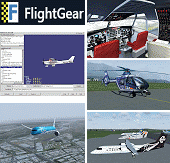 "FlightGear" is an Open Source (aka
Free) flight simulator program which I first wrote about in 2012. It has come a
long way - and was pretty dran good, aven back then - and is now a viable competitor
for Microsoft's Flight Simulator (MSFS). The leatest release as of this writing
is 2024.1.1. The graphics are superb and easily on par with MSFS. FlightGear has
a joystick interface, but I don't own a joystick, so my experience with it using
keyboard inputs. VR headsets are also supported now. The basic download comes with
a couple dozen aircraft, and there are many additional models available as separate
downloads. FlightGear runs on Windows, macOS and Linux. Thanks to all the folks
who have spent their valuable time developing FlightGear! FlightGear website: "FlightGear
is an open-source flight simulator. It supports a variety of popular platforms (Windows,
Mac, Linux, etc.) and is developed by skilled volunteers from around the world... "FlightGear" is an Open Source (aka
Free) flight simulator program which I first wrote about in 2012. It has come a
long way - and was pretty dran good, aven back then - and is now a viable competitor
for Microsoft's Flight Simulator (MSFS). The leatest release as of this writing
is 2024.1.1. The graphics are superb and easily on par with MSFS. FlightGear has
a joystick interface, but I don't own a joystick, so my experience with it using
keyboard inputs. VR headsets are also supported now. The basic download comes with
a couple dozen aircraft, and there are many additional models available as separate
downloads. FlightGear runs on Windows, macOS and Linux. Thanks to all the folks
who have spent their valuable time developing FlightGear! FlightGear website: "FlightGear
is an open-source flight simulator. It supports a variety of popular platforms (Windows,
Mac, Linux, etc.) and is developed by skilled volunteers from around the world...
 The October 1950 Air Trails magazine
showcases
modelers' innovations, including H.G. Oliver's Plexiglas skids for speed models
and Don Nelson's booster battery setup. Ray Biernacki suggests keeping brushes soft
with thinner fumes, while Richard Larson offers a footswitch for bench testing.
Ted Jones improves dethermalizer safety, and Charles Francis simplifies its design.
Willard Hafler's flying wing excels in speed and sport flying, and Leon Shulman
repurposes a crankcase recess as a fuel tank. The magazine encourages readers to
submit their own ideas, paying $2 per accepted sketch. These practical, cost-saving
solutions highlight the creativity of mid-century model aviation enthusiasts, blending
engineering ingenuity with accessible materials - a snapshot of hobbyist innovation
in postwar America... The October 1950 Air Trails magazine
showcases
modelers' innovations, including H.G. Oliver's Plexiglas skids for speed models
and Don Nelson's booster battery setup. Ray Biernacki suggests keeping brushes soft
with thinner fumes, while Richard Larson offers a footswitch for bench testing.
Ted Jones improves dethermalizer safety, and Charles Francis simplifies its design.
Willard Hafler's flying wing excels in speed and sport flying, and Leon Shulman
repurposes a crankcase recess as a fuel tank. The magazine encourages readers to
submit their own ideas, paying $2 per accepted sketch. These practical, cost-saving
solutions highlight the creativity of mid-century model aviation enthusiasts, blending
engineering ingenuity with accessible materials - a snapshot of hobbyist innovation
in postwar America...
 "IEEE Spectrum interviewed Bertrand Piccard
at a pivotal moment in the hydrogen-powered aircraft project, with the plane, called
Climate Impulse,
about 40 percent built. Piccard spoke about the contributions of his corporate sponsors,
including Airbus, to the Climate Impulse project and about why he's confident that
hydrogen will eventually succeed as an aviation fuel. He'll fly around the world
in a hydrogen fuel-cell aircraft. Few explorers have reached the heights, literally
and figuratively, that Bertrand Piccard has. He is the quintessential modern explorer,
for whom every big mission has a purpose, which generally boils down to environmental
and climate-change awareness. In 1999, he was the first person to circumnavigate..." "IEEE Spectrum interviewed Bertrand Piccard
at a pivotal moment in the hydrogen-powered aircraft project, with the plane, called
Climate Impulse,
about 40 percent built. Piccard spoke about the contributions of his corporate sponsors,
including Airbus, to the Climate Impulse project and about why he's confident that
hydrogen will eventually succeed as an aviation fuel. He'll fly around the world
in a hydrogen fuel-cell aircraft. Few explorers have reached the heights, literally
and figuratively, that Bertrand Piccard has. He is the quintessential modern explorer,
for whom every big mission has a purpose, which generally boils down to environmental
and climate-change awareness. In 1999, he was the first person to circumnavigate..."
 Amazingly, even during the Cold War years
it was not uncommon to see aircraft modelers from the "Iron Curtain"
countries participating in international contests. Even Commies like flying model
airplanes. Because their societies and politics were so closed and guarded, getting
information about their modeling supplies was darn near impossible except during
events where inspection could be made. Being a generally friendly bunch of guys,
the modelers would share their designs with the Free World, and vice versa. Then,
in subsequent years the Commies would show up with equipment that was exact replicas
of ours - copyrights and trademarks held no legal weight behind the Iron Curtain.
Truth be know, most or all of the participants were probably KGB agents (or other
Commie country equivalents) engaging... Amazingly, even during the Cold War years
it was not uncommon to see aircraft modelers from the "Iron Curtain"
countries participating in international contests. Even Commies like flying model
airplanes. Because their societies and politics were so closed and guarded, getting
information about their modeling supplies was darn near impossible except during
events where inspection could be made. Being a generally friendly bunch of guys,
the modelers would share their designs with the Free World, and vice versa. Then,
in subsequent years the Commies would show up with equipment that was exact replicas
of ours - copyrights and trademarks held no legal weight behind the Iron Curtain.
Truth be know, most or all of the participants were probably KGB agents (or other
Commie country equivalents) engaging...
|
 This short tongue-in-cheek article about
the use of salt mines in Communist countries like Romania for indoor free flight
contests was appeared in a 1963 issue of American Modeler magazine, at a time when
the Cold War was in full swing, your neighbor might have built a nuclear shelter
in his back yard, and kids practiced getting under their desks in the event of a
wave of incoming ICMBs tipped with MIRVs. In fact, the FAI world championships have
been held in Romanian salt mines a few times, and they will return there in 2014.
BTW, for those too young to remember, it used to be a common joke to talk about
sending someone to the Siberian salt mines as a form of punishment... This short tongue-in-cheek article about
the use of salt mines in Communist countries like Romania for indoor free flight
contests was appeared in a 1963 issue of American Modeler magazine, at a time when
the Cold War was in full swing, your neighbor might have built a nuclear shelter
in his back yard, and kids practiced getting under their desks in the event of a
wave of incoming ICMBs tipped with MIRVs. In fact, the FAI world championships have
been held in Romanian salt mines a few times, and they will return there in 2014.
BTW, for those too young to remember, it used to be a common joke to talk about
sending someone to the Siberian salt mines as a form of punishment...
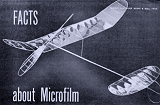 Microfilm-covered indoor models is one (of
many) aspects of model airplane building and flying that I've always wanted to try,
but never found the opportunity. You might be tempted to think this is the exclusive
realm of white-haired old men, and admittedly it nearly is, but when you look at
contest coverage in the modeling magazines, it is heartening to see a good showing
of youngsters. For that matter, the same holds true for just about all forms of
model aircraft these days except for radio controlled airplanes and helicopters.
As recently as a couple decades ago, radio equipment was too expensive for many
younger modelers to buy, so those who aspired to hobbies involving airborne craft
had to settle for free flight and control line. Now, the department store shelves
hold no control line or free flight models, but a nice selection of miniature R/C
helis and airplanes. But I digress. This 1954 Model Airplanes News magazine
article by John Zaic is a very comprehensive set of instructions on how to cover
airframes with microfilm, a pyroxylin... Microfilm-covered indoor models is one (of
many) aspects of model airplane building and flying that I've always wanted to try,
but never found the opportunity. You might be tempted to think this is the exclusive
realm of white-haired old men, and admittedly it nearly is, but when you look at
contest coverage in the modeling magazines, it is heartening to see a good showing
of youngsters. For that matter, the same holds true for just about all forms of
model aircraft these days except for radio controlled airplanes and helicopters.
As recently as a couple decades ago, radio equipment was too expensive for many
younger modelers to buy, so those who aspired to hobbies involving airborne craft
had to settle for free flight and control line. Now, the department store shelves
hold no control line or free flight models, but a nice selection of miniature R/C
helis and airplanes. But I digress. This 1954 Model Airplanes News magazine
article by John Zaic is a very comprehensive set of instructions on how to cover
airframes with microfilm, a pyroxylin...
 Since this membership application for the
Academy of Model Aeronautics (AMA) brings up the subject of inflation, I figured
it would be interesting to find out what the inflation rate was in 1949 when it
appeared in Air Trails magazine. According to the CPI Inflation Calculator, the
rate in 1949 was actually negative (-1.2%) due to a multi-year economic recession
triggered by President Truman's "Fair Deal"; however, in the previous year (1948)
it was a whopping 8.1%, and the year before that (1947) it was an incredible 14.4%!!!
So, massive inflation was definitely still on the minds of Americans at the time.
The current inflation rate (March 2022) is sitting at 8.5%, with no sign of things
getting any better. In fact, economists say if the inflation rate was calculated
the way it was in 1949, it would be in the 15% realm. According to the BLS Inflation
Calculator, what would have cost you $1.00 in September 1949 will cost you $12.03
in March of 2022. That's 1,203% inflation in about 73 years, which averages to about
1.102% per year (1.102^73 = 1,200). Clearly, we are currently in a period of significant
inflation, but that's what we get when the government prints money like mad and
dilutes the value of every dollar in your pocket... Since this membership application for the
Academy of Model Aeronautics (AMA) brings up the subject of inflation, I figured
it would be interesting to find out what the inflation rate was in 1949 when it
appeared in Air Trails magazine. According to the CPI Inflation Calculator, the
rate in 1949 was actually negative (-1.2%) due to a multi-year economic recession
triggered by President Truman's "Fair Deal"; however, in the previous year (1948)
it was a whopping 8.1%, and the year before that (1947) it was an incredible 14.4%!!!
So, massive inflation was definitely still on the minds of Americans at the time.
The current inflation rate (March 2022) is sitting at 8.5%, with no sign of things
getting any better. In fact, economists say if the inflation rate was calculated
the way it was in 1949, it would be in the 15% realm. According to the BLS Inflation
Calculator, what would have cost you $1.00 in September 1949 will cost you $12.03
in March of 2022. That's 1,203% inflation in about 73 years, which averages to about
1.102% per year (1.102^73 = 1,200). Clearly, we are currently in a period of significant
inflation, but that's what we get when the government prints money like mad and
dilutes the value of every dollar in your pocket...
 Many moons ago I designed and built a combined
salt & pepper
and napkin holder for use on a round oak table we had when first married (1983).
It had a Lazy Susan turntable for the base to facilitate easy access by anyone sitting
at the table. At some point during our many household moves, we sold both the table
and the turntable at a yard sale. For a long time I have been planning to build
another to replace it. Finally, I used some leftover hickory wood from my Grandmother
clock project and built what you see here. It is about 11½" in diameter; the size
was kept as small as practical so as not to take up too much room on the table.
One improvement over the first iteration was only placing vertical supports near
the four corners, which keeps the back open for inserting napkins without needing
to remove the salt and pepper shakers... Many moons ago I designed and built a combined
salt & pepper
and napkin holder for use on a round oak table we had when first married (1983).
It had a Lazy Susan turntable for the base to facilitate easy access by anyone sitting
at the table. At some point during our many household moves, we sold both the table
and the turntable at a yard sale. For a long time I have been planning to build
another to replace it. Finally, I used some leftover hickory wood from my Grandmother
clock project and built what you see here. It is about 11½" in diameter; the size
was kept as small as practical so as not to take up too much room on the table.
One improvement over the first iteration was only placing vertical supports near
the four corners, which keeps the back open for inserting napkins without needing
to remove the salt and pepper shakers...
 The X-15 was an experimental aircraft developed
by NASA and the U.S. Air Force in the 1950s and 1960s. It was a rocket-powered aircraft
designed to explore the high-speed and high-altitude flight regimes. The X-15 program
aimed to gather data on aerodynamics, structural heat resistance, and control systems
for future space and hypersonic vehicles. The X-15 was primarily built for research
purposes, aiming to push the boundaries of manned flight. It provided valuable data
on the effects of high speeds, altitudes, and temperatures on aircraft and human
physiology. The X-15 achieved impressive speeds, with its fastest recorded speed
being Mach 6.7 (about 4,520 miles per hour). It also reached altitudes of up to
354,200 feet. The X-15 was flown by a select group of experienced test pilots, including
Neil Armstrong. From 1959 to 1968, the X-15 completed a total of 199 flights... The X-15 was an experimental aircraft developed
by NASA and the U.S. Air Force in the 1950s and 1960s. It was a rocket-powered aircraft
designed to explore the high-speed and high-altitude flight regimes. The X-15 program
aimed to gather data on aerodynamics, structural heat resistance, and control systems
for future space and hypersonic vehicles. The X-15 was primarily built for research
purposes, aiming to push the boundaries of manned flight. It provided valuable data
on the effects of high speeds, altitudes, and temperatures on aircraft and human
physiology. The X-15 achieved impressive speeds, with its fastest recorded speed
being Mach 6.7 (about 4,520 miles per hour). It also reached altitudes of up to
354,200 feet. The X-15 was flown by a select group of experienced test pilots, including
Neil Armstrong. From 1959 to 1968, the X-15 completed a total of 199 flights...
 The term "drone"
is relatively new to being common parlance throughout society. Prior to the early
2000s, a drone was thought of as either the mate to a queen bee or a special remotely
controlled aircraft used by the military for target practice or for carrying out
special missions not deemed safe for human pilots. When this article appeared in
a 1952 issue of Radio & Television News magazine, drones were the exclusive
purview of the military and research institutions because of high procurement and
operational costs. With the advent of inexpensive, highly advanced spread spectrum
radio control systems by the hobby community, lightweight and powerful brushless
motors and lithium polymer (LiPo) batteries, sophisticated miniature stability and
guidance integrated circuits (processors and sensors), and advanced computer simulation,
incredibly capable and relatively inexpensive multirotor drones are widely available.
From simple toys for erstwhile non-pilots to serious R/C flyers to professional
operators, drones are everywhere. A couple days ago I saw a utility company worker
using one to inspect power lines along a country road... The term "drone"
is relatively new to being common parlance throughout society. Prior to the early
2000s, a drone was thought of as either the mate to a queen bee or a special remotely
controlled aircraft used by the military for target practice or for carrying out
special missions not deemed safe for human pilots. When this article appeared in
a 1952 issue of Radio & Television News magazine, drones were the exclusive
purview of the military and research institutions because of high procurement and
operational costs. With the advent of inexpensive, highly advanced spread spectrum
radio control systems by the hobby community, lightweight and powerful brushless
motors and lithium polymer (LiPo) batteries, sophisticated miniature stability and
guidance integrated circuits (processors and sensors), and advanced computer simulation,
incredibly capable and relatively inexpensive multirotor drones are widely available.
From simple toys for erstwhile non-pilots to serious R/C flyers to professional
operators, drones are everywhere. A couple days ago I saw a utility company worker
using one to inspect power lines along a country road...
 This
Prop-Rod
car was one of the earliest models produced by L.M. Cox Manufacturing. For many
years the models went by the trade name of Thimble Drome, but later were know
simply as Cox models. It was featured in magazine advertisements as early as
1961 when it appeared in American Modeler. The Prop-Rod came it a Babe Bee .049
engine that had an inverted cylinder. It was designed to run either on a tether
stretched along a sidewalk, on a tether mounted in the center of a circle (see
video below), or it could just run free. These couple photos were captured from
an eBay auction a while back. The Prop-Rod was a little over 12 inches long and
6 inches wide ... This
Prop-Rod
car was one of the earliest models produced by L.M. Cox Manufacturing. For many
years the models went by the trade name of Thimble Drome, but later were know
simply as Cox models. It was featured in magazine advertisements as early as
1961 when it appeared in American Modeler. The Prop-Rod came it a Babe Bee .049
engine that had an inverted cylinder. It was designed to run either on a tether
stretched along a sidewalk, on a tether mounted in the center of a circle (see
video below), or it could just run free. These couple photos were captured from
an eBay auction a while back. The Prop-Rod was a little over 12 inches long and
6 inches wide ...
 Leroy M. Cox built his glow fuel powered
model empire by being not only an innovator and skilled craftsman, but also by possessing
marketing savvy. This advertisement from a 1961 issue of American Modeler
magazine is a prime example. Here,
Cox encourages modelers to spend the money they might have
received for Christmas from friends and relatives to buy some the many alluring
models the company has to offer. I know that as a kid, I drooled over every Cox
airplane, helicopter, boat, and car seen in magazines or in a store. A lot of
the more models like the Prop Rod air-powered car, the Super Sabre F-100 jet,
the Water Wizard air-powered hydroplane, and the original Super Cub 105 sell for
high prices on eBay, especially if they are in new or excellent condition and
come with the original boxes and accessories. These predated my flying days by
about six or seven years. It would be nice to have a couple of them ... Leroy M. Cox built his glow fuel powered
model empire by being not only an innovator and skilled craftsman, but also by possessing
marketing savvy. This advertisement from a 1961 issue of American Modeler
magazine is a prime example. Here,
Cox encourages modelers to spend the money they might have
received for Christmas from friends and relatives to buy some the many alluring
models the company has to offer. I know that as a kid, I drooled over every Cox
airplane, helicopter, boat, and car seen in magazines or in a store. A lot of
the more models like the Prop Rod air-powered car, the Super Sabre F-100 jet,
the Water Wizard air-powered hydroplane, and the original Super Cub 105 sell for
high prices on eBay, especially if they are in new or excellent condition and
come with the original boxes and accessories. These predated my flying days by
about six or seven years. It would be nice to have a couple of them ...
 On page 511 of the Sears 1969 Christmas
Wish Book are a few
Erector Sets. This was probably the year (±a couple) that I got
my first Erector Set. This was a step up from the Tinkertoy sets I previously owned.
While not the largest set made, it had quite a lot of parts, including a motor.
Although I already had a natural interest in assembling and - to my parents' dismay
- disassembling stuff, it was gifts like this that really helped nurture what would
become a life-long pursuit of things mechanical and electrical, eventually leading
to my earning an electrical engineering degree. I remember getting a pretty good
finger pinch by one of the motorize contraptions I built. Show above is Erector
Set #3, similar to the one I received for Christmas in 1969. This one I bought on
eBay since, as with most things I owned, the original did not survive my handling... On page 511 of the Sears 1969 Christmas
Wish Book are a few
Erector Sets. This was probably the year (±a couple) that I got
my first Erector Set. This was a step up from the Tinkertoy sets I previously owned.
While not the largest set made, it had quite a lot of parts, including a motor.
Although I already had a natural interest in assembling and - to my parents' dismay
- disassembling stuff, it was gifts like this that really helped nurture what would
become a life-long pursuit of things mechanical and electrical, eventually leading
to my earning an electrical engineering degree. I remember getting a pretty good
finger pinch by one of the motorize contraptions I built. Show above is Erector
Set #3, similar to the one I received for Christmas in 1969. This one I bought on
eBay since, as with most things I owned, the original did not survive my handling...
 One of the monthly columns in R/C Modeler
magazine, written by Chuck Cunningham, entitled "Cunningham on R/C," that reported
on the current state of radio control, which had only fairly recently evolved into
fully solid state, proportional control systems. Anyone involved in electronics
is painfully familiar with the weird kinds of issues that crop up in complex circuits
that operate in hostile environments. The March 1970 issue contained part of an
article authored by D. L. Klipstein, Director of Engineering, Measurement Control
Devices, entitled, "Murphy's
Law: The Contributions of Edsel Murphy to the Understanding of the Behaviour of
Inanimate Objects.*" Only a few of the items were printed in Cunningham's column,
but I managed to locate a copy of the full article ... One of the monthly columns in R/C Modeler
magazine, written by Chuck Cunningham, entitled "Cunningham on R/C," that reported
on the current state of radio control, which had only fairly recently evolved into
fully solid state, proportional control systems. Anyone involved in electronics
is painfully familiar with the weird kinds of issues that crop up in complex circuits
that operate in hostile environments. The March 1970 issue contained part of an
article authored by D. L. Klipstein, Director of Engineering, Measurement Control
Devices, entitled, "Murphy's
Law: The Contributions of Edsel Murphy to the Understanding of the Behaviour of
Inanimate Objects.*" Only a few of the items were printed in Cunningham's column,
but I managed to locate a copy of the full article ...
 These "Sketchbook"
pages appeared for many years in Air Trails Hobbies for Young Men magazine
and in its predecessor, Air Trails. "Sketchbook" was a monthly feature
where modelers wrote to the magazine with handy ideas for saving time and/or money,
and just for offering tips and suggestions on a different way of doing something.
Prior to having information on just about every topic readily available on the Internet,
modelers had to rely on books, magazines, friends, and personal ingenuity. Also,
in those days there was not the plethora of accessories available for building models,
so a lot of creativity was involved. Even items as commonplace as bellcranks for
control line models and dethermalizers for free flight were fabricated from salvaged
parts like metal soup cans and hairpins. I'm guessing no magazine today would dare
publish a scheme to attach bottle rockets to a model airplane as is shown here,
lest Homeland Security or the FBI show up at the editor's door in the early morning
hours with a fully outfitted SWAT team... These "Sketchbook"
pages appeared for many years in Air Trails Hobbies for Young Men magazine
and in its predecessor, Air Trails. "Sketchbook" was a monthly feature
where modelers wrote to the magazine with handy ideas for saving time and/or money,
and just for offering tips and suggestions on a different way of doing something.
Prior to having information on just about every topic readily available on the Internet,
modelers had to rely on books, magazines, friends, and personal ingenuity. Also,
in those days there was not the plethora of accessories available for building models,
so a lot of creativity was involved. Even items as commonplace as bellcranks for
control line models and dethermalizers for free flight were fabricated from salvaged
parts like metal soup cans and hairpins. I'm guessing no magazine today would dare
publish a scheme to attach bottle rockets to a model airplane as is shown here,
lest Homeland Security or the FBI show up at the editor's door in the early morning
hours with a fully outfitted SWAT team...
 When deciding which type of covering material
to apply to a model airplane structure, it would be helpful to have a table of
covering density for comparison. Here
is such a table which shows, for instance, that 21st Century Fabric is the heaviest
type of covering you can use. MicroLite covering is the lightest weight. Not shown
are most doped or painted coverings because finished weights are so dependent on
substrate type (silk, Silkspan, tissue, etc.), paint or dope type, and number/thickness
of coats. To calculate the covering weight, multiply the density by the total surface
area of your model. Unfortunately, most of these coverings are no longer manufactured,
but a lot of it can still be found on eBay... When deciding which type of covering material
to apply to a model airplane structure, it would be helpful to have a table of
covering density for comparison. Here
is such a table which shows, for instance, that 21st Century Fabric is the heaviest
type of covering you can use. MicroLite covering is the lightest weight. Not shown
are most doped or painted coverings because finished weights are so dependent on
substrate type (silk, Silkspan, tissue, etc.), paint or dope type, and number/thickness
of coats. To calculate the covering weight, multiply the density by the total surface
area of your model. Unfortunately, most of these coverings are no longer manufactured,
but a lot of it can still be found on eBay...
 Fresh off the Flying Aces magazine
press (in 1934) is this article and plans for a rubber-powered free flight
Stinson
Reliant model. The 26-inch wingspan craft drawn and built by author Avrum Zier
is of customary construction with balsa sticks and Jap tissue covering. A carved
cowl and wheel pants, and paper landing gear fairings make for a very nice look.
There five plans sheets that can be scaled up or down to suit your needs. Send me
an e-mail if you need higher resolution plans files. Fresh off the Flying Aces magazine
press (in 1934) is this article and plans for a rubber-powered free flight
Stinson
Reliant model. The 26-inch wingspan craft drawn and built by author Avrum Zier
is of customary construction with balsa sticks and Jap tissue covering. A carved
cowl and wheel pants, and paper landing gear fairings make for a very nice look.
There five plans sheets that can be scaled up or down to suit your needs. Send me
an e-mail if you need higher resolution plans files.
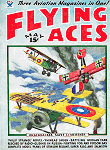 Flying Aces magazine featured a monthly
"Aviation
News" column that covered both model and full-size aviation happenings across
the country and on foreign soil. This 1934 issue reported on the land-based "lighthouses"
which were established throughout the land in order to guide airplanes from airport
to airport. Not much in the way of radio direction finding was available at the
time, and this method was more consistent and reliable than having farmers build
bonfires in their fields for pilots to look for. "Dead reckoning" was still the
order of the day back then. Compared to today where only in the most remote areas
are lacking any manmade visual object to positive identification while navigating,
real "seat of the pants" skill was required to fly cross-country routes without
getting lost. Nowadays, GPS-linked and/or inertial navigation systems can flying
an airplane from point A to point B without any assistance from a human. Also
told... Flying Aces magazine featured a monthly
"Aviation
News" column that covered both model and full-size aviation happenings across
the country and on foreign soil. This 1934 issue reported on the land-based "lighthouses"
which were established throughout the land in order to guide airplanes from airport
to airport. Not much in the way of radio direction finding was available at the
time, and this method was more consistent and reliable than having farmers build
bonfires in their fields for pilots to look for. "Dead reckoning" was still the
order of the day back then. Compared to today where only in the most remote areas
are lacking any manmade visual object to positive identification while navigating,
real "seat of the pants" skill was required to fly cross-country routes without
getting lost. Nowadays, GPS-linked and/or inertial navigation systems can flying
an airplane from point A to point B without any assistance from a human. Also
told...
 While living in Colorado Springs, CO, in
the 1990s, our family decided to build a compact
N-gauge model train layout that
looked like the northwestern Nebraska landscape that we had driven through many
time. It represents the old west that comes to mind from the Oregon Trail days,
although that pre-dated the train routes of the day. An inexpensive Lionel N-gauge
train set was purchased, along with a few extra sections of track. Since space was
very limited, a 4' x 4' platform was used, and was cut out of 3/4" plywood in order
to make it rugged enough to be moved around. Three sides were cut from the remaining
4' x 8' sheet. Unfortunately, digital cameras were not the norm then, so I didn't
take a lot of photos throughout the process. Styrofoam sheets were cut and sanded
to form the track underlayment, the hills, and tunnel, then gauze impregnated with
a plaster mix was applied over top of it all. Trees and underbrush, the pond water,
and faux grass... While living in Colorado Springs, CO, in
the 1990s, our family decided to build a compact
N-gauge model train layout that
looked like the northwestern Nebraska landscape that we had driven through many
time. It represents the old west that comes to mind from the Oregon Trail days,
although that pre-dated the train routes of the day. An inexpensive Lionel N-gauge
train set was purchased, along with a few extra sections of track. Since space was
very limited, a 4' x 4' platform was used, and was cut out of 3/4" plywood in order
to make it rugged enough to be moved around. Three sides were cut from the remaining
4' x 8' sheet. Unfortunately, digital cameras were not the norm then, so I didn't
take a lot of photos throughout the process. Styrofoam sheets were cut and sanded
to form the track underlayment, the hills, and tunnel, then gauze impregnated with
a plaster mix was applied over top of it all. Trees and underbrush, the pond water,
and faux grass...
 We needed some nice, strong, low profile
wooden carpet-to-tile
transition molding strips to install between very dense carpet (w/padding) and
thick vinyl floor tiles. An area inside our front door, and also the two bathroom
doorways needed the molding. Commercially available transition strips made of solid
wood are very expensive, and even the el cheapo variety made of "wood products"
with a faux grain layer on top is expensive. None that I could find would have done
a good job, anyway, because the dimensions were not right. I wanted the molding
to make intimate contact with the underlayment while allowing the floating vinyl
floor tiles to have freedom to expand and contract, with minimal thickness on top
to minimize tripping hazards. The carpet side needed to compress the piles enough
to hold the edge securely on the tack strip while not distorting the piling excessively.
I have the tools required to do a custom molding, but really didn't want to put
in the effort unless absolutely necessary. Ultimately, doing it myself was the best
choice, and I'm glad of it now that it's done... We needed some nice, strong, low profile
wooden carpet-to-tile
transition molding strips to install between very dense carpet (w/padding) and
thick vinyl floor tiles. An area inside our front door, and also the two bathroom
doorways needed the molding. Commercially available transition strips made of solid
wood are very expensive, and even the el cheapo variety made of "wood products"
with a faux grain layer on top is expensive. None that I could find would have done
a good job, anyway, because the dimensions were not right. I wanted the molding
to make intimate contact with the underlayment while allowing the floating vinyl
floor tiles to have freedom to expand and contract, with minimal thickness on top
to minimize tripping hazards. The carpet side needed to compress the piles enough
to hold the edge securely on the tack strip while not distorting the piling excessively.
I have the tools required to do a custom molding, but really didn't want to put
in the effort unless absolutely necessary. Ultimately, doing it myself was the best
choice, and I'm glad of it now that it's done...
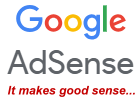 Some companies
have expressed an interest in being able to target Airplanes and Rockets via the
Google
AdSense program. Yes, it is possible to do that. As you might expect, finding
the exact information on the Google AdSense website is a bit difficult. This short
video does a good job summarizing exactly how to implement the "Ad Targeting" option,
then "Placements," and then add "Websites." Just enter airplanesandrockets.com
. There are other settings to optimize your advertising campaign with keywords (both
included and excluded), pricing, scheduling, statistical data collection and reporting,
etc. If you are currently using Google AdSense, then please consider this method,
and if you are not using AdSense, now would be a good time to look into it. I have
had reports from some companies that experience great results using AdSense (not
just on Airplanes and Rockets)... Some companies
have expressed an interest in being able to target Airplanes and Rockets via the
Google
AdSense program. Yes, it is possible to do that. As you might expect, finding
the exact information on the Google AdSense website is a bit difficult. This short
video does a good job summarizing exactly how to implement the "Ad Targeting" option,
then "Placements," and then add "Websites." Just enter airplanesandrockets.com
. There are other settings to optimize your advertising campaign with keywords (both
included and excluded), pricing, scheduling, statistical data collection and reporting,
etc. If you are currently using Google AdSense, then please consider this method,
and if you are not using AdSense, now would be a good time to look into it. I have
had reports from some companies that experience great results using AdSense (not
just on Airplanes and Rockets)...
|



